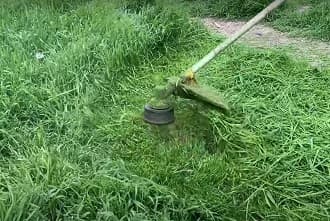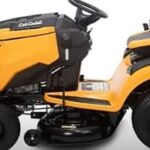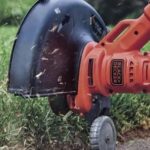As an Amazon Associate, this site earns commissions from qualifying purchases. For more information click here.
Whether you call it a string trimmer, weed whacker or weed eater, there is no question that this is a versatile tool. String trimmers or weed whackers are used to get rid of weeds and trim grass, but did you know it can also be a mulching tool? Yes, and in this article we show you how it is done.
A string trimmer makes mulching easy. Put the leaves in a trash can until it is filled halfway. Put the string trimmer in the can, turn it on and it will shred the leaves.
There are a lot of ways to mulch leaves, but a weed whacker is one of the most effective methods. For this to work, make sure all the tools and materials are ready.
How to Mulch Leaves with a Weed Whacker
What You Will Need
- Weed whacker (we prefer the Black + Decker BESTA510 electric string trimmer)
- A container for the leaves (a plastic garbage can is ideal)
- Safety protection gear
- Rake, lawn sweeper or leaf blower
Step 1
Wear your personal protection equipment. At the most basic level you need long pants, a long sleeve shirt and eye goggles. You might also want to wear thick shoes or steel toe shoes. If there are sharp rocks in the area, feet protection will be needed.
Prepare all the tools and materials listed above. A Lilyvane rake will do fine for dry leaves. If they are wet, a lawn sweeper or leaf blower is better.
Any container that can hold leaves is fine. You can even use a tarp and just lay the leaves there. The important thing is the container is large enough. In most cases, a garbage can is the best option.
Step 2
Bring a thrash can to the area where you will mulch. It can be any height, but should be enough to put a good amount of leaves.
You can use any type of thrash can, but plastic is ideal because it will mitigate the sound made by the trimmer. Shredding leaves inside a metal container will be noisy. It is quieter with plastic.
Now it is time to gather the leaves. If they are dry, use a rake. If the leaves are wet, it might be difficult to rake them to the spot.
If a rake does not work, use a leaf blower to blow the leaves in the general direction you want. Then you can collect and put them in the can.
Fill the thrash can until it is 50% full. You want to leave some room for the weed whacker to operate.
Step 3
Make sure your weed whacker is ready. If it is gas-powered, fill it with fuel. If you are using an electric weed whacker, check if the cord is long enough. Charge the trimmer if it runs on batteries.
Once the trimmer is ready, turn it on. Do not forget to warm up your weed eater if it runs on gas. For electric or battery weed eaters, press a button.
Put the trimmer inside the container. The string is going to start shredding the leaves.
Move the trimmer in an up and down motion. Move side to side occasionally. Keep the head in the middle as much as possible.
After 5 minutes, stop mulching and allow the engine to cool down. Look inside the can. The leaves should be shredded by now. Empty the can and put in a fresh batch of leaves. Turn the trimmer on and start shredding.
So the process is simple: shred for 5 minutes, stop, empty the can, put in new leaves and shred again. Keep repeating until you have all the leaves you need.
Step 4
When you are done, let the engine cool down before shutting it off. Because you collected the leaves in on spot, it made shredding easier.
Now you can use those leaves for mulch, fertilizer or compost among other things. You can use the leaves as plant fertilizers or place them in garden beds. Gather all the leaves and use them as mulch, compost or fertilizer. It won’t take long until you have cleared away all the leaves.
Step 5
Clean the weed whacker after you are done. Remove any leaves stuck in the trimmer head. Check the air filter too because it might be clogged already.
This video shows you how it is done.
Safety Tips for Using a Weed Whacker for Mulching
Weed whackers come in different styles, but they all use the method: a spinning line to cut grass and weeds. The same line can be used to shred leaves. If you followed the steps given here, you can see how straightforward it is. But there are other ways to do it better.
Always wear protection. Shredding leaves seems very safe, but the line in a weed whacker is sharp and can cut. Plus you might get hit by small rocks when gathering or shredding leaves.
Remove rocks and sticks from the leaf pile. These debris can cause two problems. One, rocks and other debris will go off flying and could hit you. This is why wearing protective gear is a much. Second, the could get stuck in the head. This can cause the trimmer to slow down or stop running.
Watch out for the cord. If you use an electric weed whacker, be mindful of the cord. Before you start, check if the cord is long enough to cover the distance from the power source to where the leaves are.
Second, be careful not to cut the cord. If you lay all the leaves on a tarp for instance, you might suddenly pull the trimmer and cut the cord. This will not happen if you put the leaves in a thrash can though.
If you are using a battery-powered trimmer, cords will not be a problem. But you could run out of power in the middle of the task. A fully charged battery is recommended.
Gas-powered trimmers are the most powerful, but you have to be careful when handling fuel. Use only the recommended gas and oil type by the manufacturer. Do not use fuel with more than 10% ethanol.

Frequently Asked Questions
Which is better at mulching, gas, electric or battery weed whackers?
All of them will work. Gas trimmers are the most powerful, but electric and cordless models can do the job. Regardless what type of weed whacker you use, take 5 minute breaks to avoid overheating the engine or motor. It only takes a few minutes for these tools to cool before you can resume.
Why is the trimmer not shredding any leaves?
If the trimmer has stopped, check if there is enough fuel. If it is electric, make sure the cord is still plugged in.
Turn the trimmer off and look for clogging in the head, filter or engine. Other possible causes are a faulty spark plug, clogged carburetor or dirty air filter.
How long does it take a string trimmer to shred leaves?
It depends on the volume and how powerful the trimmer is. It is most effective when the leaves are gathered in a thrash can so the string can reach a lot of them when it turns.
Is it safe to use a weed whacker for shredding and mulching?
Yes. As long as you follow all safety precautions for using the tool, everything should be fine. Keep in mind that gas trimmers emit smoke, so mulch only in well-ventilated places. Never use a weed whacker near flammable objects.
Is there a way to reduce the noise made by weed whackers while shredding leaves?
The sound you hear comes from the trimmer making contact with the container. The only way to avoid this is to use a plastic container.
Is it better to move the trimmer up and down or side to side when shredding leaves?
An up and down motion produces better results. You will see the leaves get shred more finely. However, moving the trimmer side to side every now and then while shredding also helps.

I love the outdoors and all the tools for maintaining gardens, yards and lawns. The only thing I am more passionate about is sharing what I know about garden and outdoor equipment.


